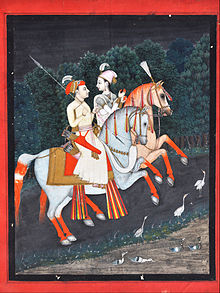Nautch
[2] The culture of the performing art of the nautch rose to prominence during the later period of Mughal Empire and the rule of the East India Company.
[4] Over time, the nautch travelled outside the confines of the imperial courts of the Mughals, the palaces of the nawabs and the princely states, and the higher echelons of the officials of the British Raj, to the places of zamindars.
As a result, many nautch girls lost their former patrons and were pushed further into prostitution, as local mistresses for the British were replaced with wives from Britain.
In 1917, attributing the adjective to a woman in India would suggest her entrancing skill, tempting style and alluring costume could mesmerize men to absolute obedience.
Very few English admire this exhibition on the first representation, but by repetition it ceases to disgust, and at length, in many cases, comes to form the chief enjoyment of life.
[10] A nautch girl is not a Domni (hereditary female singer), Kasbi (a female belonging to family which practices hereditary sex trade), Randi (first generation prostitute), Tawaif (elegant and cultured female master of arts, including singing and dancing), Kanjari (low-class uncultured Tawaif), Nochi (young girl trainee under a tawaaif) or Devdasi (temple dancer devoted to the practice of spiritual dancing); she belongs to her own distinctive class.A nautch girl is a dancer who makes a living by entertaining men, women and children of all social classes, regions, castes and religions on various occasions including parties, weddings, christenings, religious ceremonies, and other social events.
[10] They [nautch girls] are extremely delicate in their person, soft and regular in their features, with a form of perfect symmetry, and although dedicated from infancy to this profession, they in general preserve a decency and modesty in their demeanor, which is more likely to allure than the shameless effrontery of similar characters in other countries.The nautch party musicians historically played four instruments: sarangi, tabla, manjeera and dholak.
[10] A mama, usually an older and experienced maidservant, who sat in a corner of the dais preparing paan (betel nut) and beedi (Indian cigar) for patrons, was responsible for taking care of nautch girls, their meals, and safekeeping of the jewelry worn by them.
[10] The tent was most glaringly lighted, massaulchis or torch-bearers stood here and there ready to attend to any person who might require them…we had scarcely seated ourselves ere two of them made their appearance, floating into our presence, all tinsel colored muslin and ornaments: they were followed by three musicians, and attended by a couple of mussaulchis who held their torches first to the face and then lower down as if showing off the charms of the dancers to the best advantage.Roopmati was a famous Hindu nautch girl from Saharanpur, who married Baz Bahadur, the Muslim sultan of Malwa.
While the British men were happy to take local women as concubines and mistresses they were uninterested in becoming patrons of the formerly well tolerated courtesans of Lahore, and even less interested in spending lavish sums upon them.
[15] In the mid-nineteenth century, with the spread of western education and pressure from the increased number of Christian missionaries after the opening of the Suez Canal in 1869, dance was stigmatized and shunned by Europeans and Indians alike.










